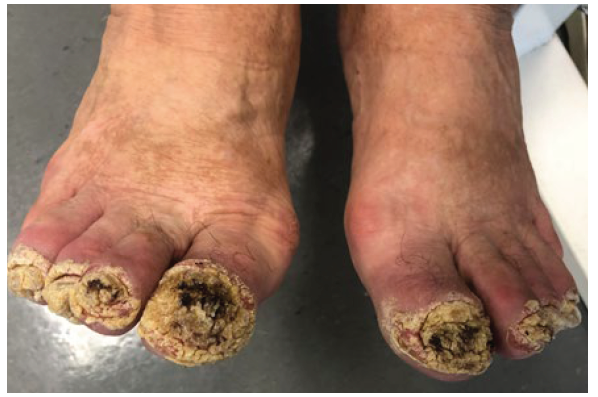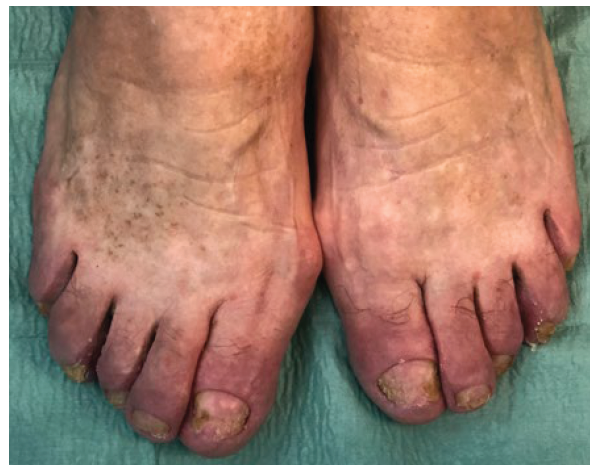A 73-year-old woman presented to our dermatology department with a 6-month history of severe nail dystrophy. Apart from cosmetic disfigurement causing psychological distress, she complained of tenderness and functional disability. Past personal history and family history were non-contributory. She denied recent introduction of new drugs. Physical examination revealed exuberant hyperkeratosis in all toenails, with subungueal hyperkeratosis and yellowish dystrophy of the nail plate that was surrounded by well-demarcated plaques with erythema and thick scales (Fig. 1). Less severe dystrophy was observed in all fingernails. No skin lesions were detected in other areas of the body, and the remaining physical examination was unremarkable. Potassium hydroxide preparation and fungal culture were negative. One month after the initial evaluation, erythematous plaques with overlying silvery scale and well-defined edges were observed in both elbows. With the diagnosis of psoriasis, the patient was treated with oral acitretin (25 mg/day) and calcipotriol plus betamethasone dipropionate ointment (0.05 mg/g + 0.5 mg/g). Significant improvement was observed after 2 months (Fig. 2), with no adverse effects. Psoriatic arthritis was excluded by rheumatology.
Nail psoriasis can be the presenting manifestation of this disease in up to 10% of patients.1 In the absence of psoriatic skin lesions, it may be a challenging diagnosis. Signs of nail psoriasis include subungual hyperkeratosis, onycholysis, oil drop discoloration, pitting, leukonychia, nail plate crumbling, and splinter hemorrhages.2 Its treatment is often lengthy and ineffective.
Biologic agents are considered the most effective therapy for moderate to severe nail psoriasis. However, various factors (eg., cost, patient preference, contraindications) may contribute to the need to use alternative therapies. Acitretin is a systemic retinoid that normalizes cellular differentiation and controls inflammation. It can reduce subungual hyperkeratosis and improve symptoms in nail psoriasis.3 Although information on this topic is scarce, evidence suggests that a 40%-50% reduction of the Nail Psoriasis Severity Index (NAPSI score) is to be expected with this drug.3,4It can be a valid alternative in the treatment of moderate to severe nail psoriasis.
.

















